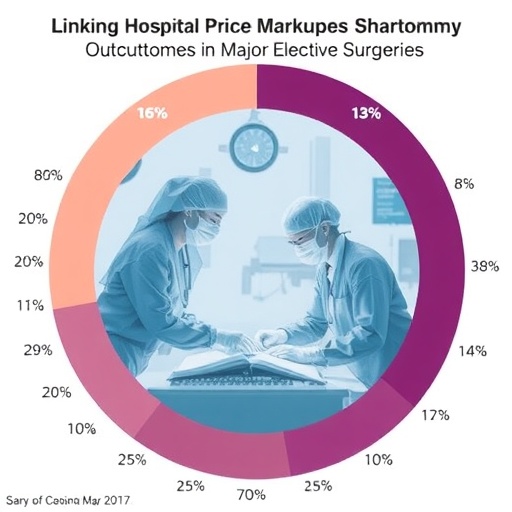A recent comprehensive cross-sectional investigation has shed light on the significant disparities in hospital pricing strategies across the United States, revealing a complex landscape where cost variations correlate inversely with quality and value in patient care. This groundbreaking study, led by a team of health economists and clinical researchers, exposes how certain hospitals impose markedly higher price markups while delivering comparatively lower-quality outcomes, thus underscoring the urgent need for targeted policy reforms within healthcare economics.
Healthcare pricing has long been a subject of intense debate among policymakers, providers, and patients alike. Yet, quantifying the precise relationship between hospital pricing and care quality has remained elusive. This new study rigorously analyzed a diverse sample of hospitals nationwide, employing advanced econometric models to adjust for patient demographics, illness severity, and regional economic factors. The findings are stark: hospitals with the highest price markups were consistently associated with suboptimal clinical outcomes and diminished value, calling into question the justification for such pricing strategies.
Central to this research is the concept of “markup,” which denotes the difference between the hospitals’ charges to patients or insurers and their actual operational costs. By dissecting billing data alongside clinical performance metrics, the investigators revealed a landscape marked by extreme variation. Some institutions applied markups exceeding 200% relative to cost, while others maintained far more conservative pricing. Intriguingly, those charging the highest markups frequently fell short on critical quality indicators, such as readmission rates, surgical complications, and patient satisfaction scores.
The study’s methodology incorporated a nuanced assessment of hospital quality, utilizing standardized national benchmarks and risk-adjusted outcome measures. These included mortality rates, procedure-specific complication frequencies, and patient-reported experience metrics — all integrated to construct a composite value index. Such a multidimensional approach ensured that pricing assessments were balanced against tangible care effectiveness, disentangling pure financial considerations from clinical excellence.
One of the most striking revelations of this work is the systematic inverse relationship identified between pricing and value delivery. Intuitively, higher prices might be expected to reflect superior technology, specialized expertise, or enhanced infrastructures, yet the data painted a contrasting narrative. High-markup hospitals often exhibited inefficiencies, overutilization of costly resources, and administrative burdens that did not translate into improved patient well-being. This misalignment exacerbates inequities in access and outcomes, particularly affecting vulnerable populations reliant on transparent and equitable health systems.
The implications for health policy are profound. As the US healthcare ecosystem grapples with spiraling costs and opaque pricing paradigms, targeting high-markup hospitals emerges as a pragmatic strategy for reform. Regulatory frameworks emphasizing price transparency, standardized billing practices, and alignment of payment incentives with quality metrics could recalibrate the market forces that currently enable these discrepancies. Such interventions could catalyze the reallocation of funding towards institutions demonstrating genuine value and clinical effectiveness.
Moreover, this research invigorates the discourse around value-based purchasing and accountable care models. By empirically documenting the divergence between financial exploitation and quality care, the study provides policymakers with robust data to justify tougher scrutiny on pricing behaviors that undermine patient trust and economic sustainability. It also challenges payers—including Medicare and private insurers—to refine their reimbursement models to penalize unjustified markups and reward demonstrable improvements in outcomes.
Clinicians and healthcare administrators may find these insights pivotal for internal benchmarking and strategic planning. Understanding where their institution stands within the markup-quality continuum can inform operational improvements and guide ethical pricing policies. Equally, healthcare consumers, often left bewildered by unpredictable billing, might benefit from tools informed by such research to make informed decisions regarding their care choices, promoting a more informed patient-centric marketplace.
This research also raises critical questions about the underlying drivers of high markup behavior. Hypotheses include market monopolization, lack of competitive pressures, and complex negotiation dynamics with insurers. High-markup hospitals may exploit brand prestige or geographic scarcity to justify elevated charges. Further studies delving into these contextual factors are essential to unravel the economic and social mechanisms perpetuating price inequities and to devise targeted corrective measures.
Technological advancements and data analytics were integral to this study’s success, enabling granular analysis across vast datasets. Machine learning algorithms facilitated pattern recognition within pricing and clinical outcomes, enhancing the precision and reliability of findings. Such methodological innovations exemplify the growing role of computational tools in healthcare research and policy formation, heralding a future where big data drives evidence-based reforms.
In conclusion, the study’s findings constitute a clarion call to action for stakeholders across the healthcare spectrum. High-markup hospitals represent a critical target for transparent pricing regulation, quality improvement initiatives, and value-based reimbursement strategies. By confronting these pricing inequities head-on, the healthcare system can move towards greater efficiency, equity, and patient-centeredness—fundamental goals in contemporary medical practice and health policy.
Subject of Research: Hospital Price Markups and Quality of Care in U.S. Hospitals
Article Title: (doi:10.1001/jamasurg.2025.3647)
Web References: To access the embargoed study: Visit the For The Media website [link not provided].
Keywords: Health care costs, Hospitals, Surgery, Health care policy, Health care




